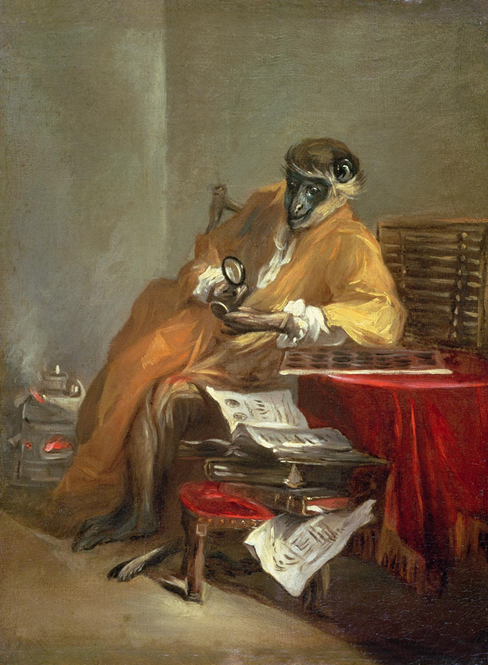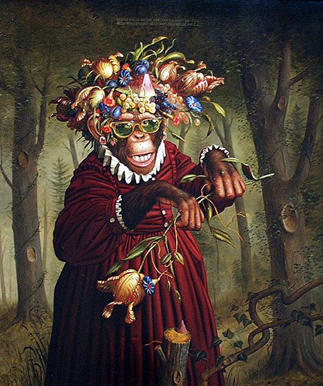Oh Brother, Oh Brother, where do we begin this Journey? Our Sojourn starts center stage...
*I used to question why humans laughed until I gained a (slippery at best) grasp of Philosophy and all of its uncertainties and it's pitfalls...*
Why does the idea of Descartes making fart jokes make me giggle? "I toot, therefore I am."...
Descartes is most famous for his statement, “I think, therefore I am.” He made this certainty the starting point of his entire philosophy. What is less known is that he died in rather unusual circumstances. He was sitting in a café one day when a waiter approached him, coffee pot in hand. “Would you like more coffee, monsieur?” asked the waiter. “I think not,” Descartes replied---and poof! . . . he disappeared.
This is an example of putting Descartes before the horse.
------------
Of course there's this old Behaviorism gem...
Q: How does a behaviorist greet another behaviorist?
A: "You're feeling fine. How am I?"
------------
It seems this is the perfect place to talk about the "Killer Joke" as postulated by Monty Pythons Flying Circus. Of course the best way to accomplish that is to let The Python boys speak for themselves...
https://youtu.be/LmYUyUSDiNk
History is full of jokes. Even the Ancient Eygyptians, Romans and Greeks had jokes...
The oldest recorded joke in the world was told 4,600 years ago to Pharoh Snefru by the magician Djadjamankh:
"How do you entertain a bored pharaoh? You sail a boatload of young women dressed only in fishing nets down the Nile and urge the Pharoh to go catch a fish,"
(Of course if the Pharoh doesn't get the joke is he in de Nile?)
Maybe not so funny now but I'm sure it was a knee slapper in its day...
Or...
A royal personage was making a tour through his provinces and noticed a man in the crowd who bore a striking resemblance to his own exalted person. He beckoned to him and asked: "Was your mother at one time in service in the Palace?" "No, your Highness," was the reply, "but my father was."
Attributed to Augustus, the first emperor.
Or this one about Socrates...
Socrates was out walking and thinking one day when he saw a young man walking by himself. He asked the young man what he was doing alone in that place.
“Talking to myself” the young man replied.
To which Socrates replied, “Watch out, be very careful: you’re in bad company.”
That's one to make a guy ponder and contemplate his role in the world...
--------------
Of course Laughter is the best remedy for what ails us. Sometimes reaching to the unkown God can bring it's own jo(y)kes...
Comicus: The Christians are so poor...
Swiftus: How poor are they?
Comicus: Thank you. They are so poor... That they only have one God.
[drumbeat, everyone laughs]
Comicus: But we Romans are rich. We've got a lot of gods. We've got a god for everything. The only thing we don't have is a god for is premature ejaculation... but I hear that's coming quickly
.
And...
A seeker approaches a hot dog vendor, who is Buddha in disguise. The venerable master says, "What can I get you, chief?"
The seeker replies, "Make me one with everything."
He gives the vendor $20, which Buddha pockets, and turns away to push his cart up the street.
"Wait! Wait!" cried the seeker, "where's my change?"
"Foolish seeker," said Buddha. "Change comes from within."
--------------
Douglas Adams made a good point in the Hitchhikers Guide to the Galaxy when he said, “We'll be saying a big hello to all intelligent lifeforms everywhere and to everyone else out there, the secret is to bang the rocks together, guys.”
--------------
Our future looks bright and sunny and full of chuckles...at least if you're a Futurist...
Higgs Boson goes to the Vatican.
The Pope says “What are you doing here?”
Higgs replies “You can’t have mass without me!”
This is one of the better ones I come across in a while...
Q: Why did the human race cross the superconsciousness threshold?
A: To get to the other side.
Q: Really?
A: No, but you wouldn’t understand the actual punchline.
And...
A robot walks into a bar, orders a drink, and lays down some cash. The bartender says, “Hey, we don’t serve robots.” The robot says, “Oh, but someday you will.”
-----------
No reflection on Humour and Philosophy would be complete without the old caveman stand by...
Caveman 1: ARRGGHH! UUUGGHH, OOG?
Caveman 2: OOG?
Caveman 1: UUUGGHH OOGG!!!
I'll be here all Reincarnation! Try the Falafel. And don't forget to tip your waitress. Salt isn't just a seasoning you know!...
Why does the idea of Descartes making fart jokes make me giggle? "I toot, therefore I am."...
Descartes is most famous for his statement, “I think, therefore I am.” He made this certainty the starting point of his entire philosophy. What is less known is that he died in rather unusual circumstances. He was sitting in a café one day when a waiter approached him, coffee pot in hand. “Would you like more coffee, monsieur?” asked the waiter. “I think not,” Descartes replied---and poof! . . . he disappeared.
This is an example of putting Descartes before the horse.
------------
Of course there's this old Behaviorism gem...
Q: How does a behaviorist greet another behaviorist?
A: "You're feeling fine. How am I?"
------------
It seems this is the perfect place to talk about the "Killer Joke" as postulated by Monty Pythons Flying Circus. Of course the best way to accomplish that is to let The Python boys speak for themselves...
https://youtu.be/LmYUyUSDiNk
History is full of jokes. Even the Ancient Eygyptians, Romans and Greeks had jokes...
The oldest recorded joke in the world was told 4,600 years ago to Pharoh Snefru by the magician Djadjamankh:
"How do you entertain a bored pharaoh? You sail a boatload of young women dressed only in fishing nets down the Nile and urge the Pharoh to go catch a fish,"
(Of course if the Pharoh doesn't get the joke is he in de Nile?)
Maybe not so funny now but I'm sure it was a knee slapper in its day...
Or...
A royal personage was making a tour through his provinces and noticed a man in the crowd who bore a striking resemblance to his own exalted person. He beckoned to him and asked: "Was your mother at one time in service in the Palace?" "No, your Highness," was the reply, "but my father was."
Attributed to Augustus, the first emperor.
Or this one about Socrates...
Socrates was out walking and thinking one day when he saw a young man walking by himself. He asked the young man what he was doing alone in that place.
“Talking to myself” the young man replied.
To which Socrates replied, “Watch out, be very careful: you’re in bad company.”
That's one to make a guy ponder and contemplate his role in the world...
--------------
Of course Laughter is the best remedy for what ails us. Sometimes reaching to the unkown God can bring it's own jo(y)kes...
Comicus: The Christians are so poor...
Swiftus: How poor are they?
Comicus: Thank you. They are so poor... That they only have one God.
[drumbeat, everyone laughs]
Comicus: But we Romans are rich. We've got a lot of gods. We've got a god for everything. The only thing we don't have is a god for is premature ejaculation... but I hear that's coming quickly
.
And...
A seeker approaches a hot dog vendor, who is Buddha in disguise. The venerable master says, "What can I get you, chief?"
The seeker replies, "Make me one with everything."
He gives the vendor $20, which Buddha pockets, and turns away to push his cart up the street.
"Wait! Wait!" cried the seeker, "where's my change?"
"Foolish seeker," said Buddha. "Change comes from within."
--------------
Douglas Adams made a good point in the Hitchhikers Guide to the Galaxy when he said, “We'll be saying a big hello to all intelligent lifeforms everywhere and to everyone else out there, the secret is to bang the rocks together, guys.”
--------------
Our future looks bright and sunny and full of chuckles...at least if you're a Futurist...
Higgs Boson goes to the Vatican.
The Pope says “What are you doing here?”
Higgs replies “You can’t have mass without me!”
This is one of the better ones I come across in a while...
Q: Why did the human race cross the superconsciousness threshold?
A: To get to the other side.
Q: Really?
A: No, but you wouldn’t understand the actual punchline.
And...
A robot walks into a bar, orders a drink, and lays down some cash. The bartender says, “Hey, we don’t serve robots.” The robot says, “Oh, but someday you will.”
-----------
No reflection on Humour and Philosophy would be complete without the old caveman stand by...
Caveman 1: ARRGGHH! UUUGGHH, OOG?
Caveman 2: OOG?
Caveman 1: UUUGGHH OOGG!!!
I'll be here all Reincarnation! Try the Falafel. And don't forget to tip your waitress. Salt isn't just a seasoning you know!...





























